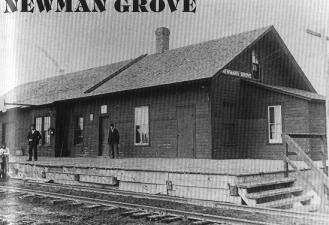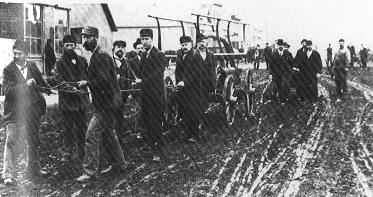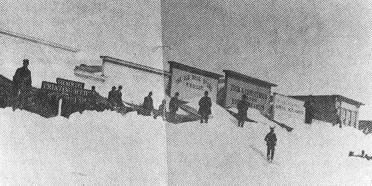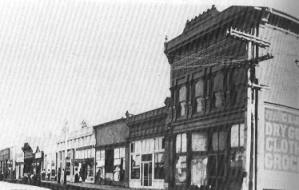 NEWMAN
GROVE -- MADISON COUNTY NEWMAN
GROVE -- MADISON COUNTY
Bluestem grass, as high as a horse's back, covered
the prairie
when Lewis Warren and his family came to Shell Creek
Valley. He
told of planting his first sod corn with an ax. When
Sioux
Indians killed some of his cattle, the settlers
asked that
soldiers help protect the families in the area.
Warren's son, Newman, helped plant a large grove of
cottonwood
trees on their timber claim. After Newman's death at
age 21, his
father was instrumental in naming the post office,
established in
1874, "Newman Grove." Located near that grove of
trees,
it was housed in the stage station on the mail route
from
Columbus to Oakdale.
 The coming
of the Fremont, Elkhorn & Missouri Valley
Railroad in 1887
presented an opportunity for a town, complete with
stores,
businesses, and all that transportation could mean
for the area.
The Western Townlot Company, formed by pioneers,
Pike, Searle,
Burrows, Hale, and Bordwell, platted the town. Five
streets carry
their names. The coming
of the Fremont, Elkhorn & Missouri Valley
Railroad in 1887
presented an opportunity for a town, complete with
stores,
businesses, and all that transportation could mean
for the area.
The Western Townlot Company, formed by pioneers,
Pike, Searle,
Burrows, Hale, and Bordwell, platted the town. Five
streets carry
their names.
Early settlers came from a variety of eastern
states as well
as Scotland, Denmark, Germany, Czechoslovakia, and
Russia, with
the majority coming from Norway and Sweden. They
established
schools and churches almost before their homes were
completed.
These institutions continue to be important today.
The town continued a steady growth, with nearly 300
people by
1888. The Arcade and Commercial hotels provided
rooms for
travelers and salesmen, and were known for their
fine dining
rooms.
For many years Newman Grove was "the place to be"
on
the 4th of July. Passenger trains brought people
from neighboring
communities, and everyone within a 40-mile radius
came to the
celebration. The military band opened the
festivities. The
Declaration of Independence was read, political
speeches were
given, and there were contests for young and old,
floats, and
fireworks.
 In the
1890s water power for a roller mill was supplied by
a dam on
Shell Creek. "The New Era," the first and only
newspaper, was published by H.R. Ellsworth, and
businessmen
included: Searles, Dimock, Olson, Young, Anderson,
Smith, Saare,
Guenther, Lind, From, Ninman, Randall, South,
Gustavson, and
Johnson. In the
1890s water power for a roller mill was supplied by
a dam on
Shell Creek. "The New Era," the first and only
newspaper, was published by H.R. Ellsworth, and
businessmen
included: Searles, Dimock, Olson, Young, Anderson,
Smith, Saare,
Guenther, Lind, From, Ninman, Randall, South,
Gustavson, and
Johnson.
Thomas Ostergaard established a park at Shell
Creek, with an
area for swimming, fishing, and picnics. Known later
as part of
Acorn Valley, the trees are still very beautiful.
The population was an all-time high, 1,260, in
1920. This was
reflected by the number of businesses, paved
streets, sidewalks,
and electric street lights, supplied by Nebraska Gas
&
Electric Company.
During the Depression and drought, people continued
to
"pioneer," trying to find new ways to keep their
homes
and land. It was not an easy task. After World War
II, farms
became larger, so the population decreased.
In 1974 the Newman Grove hospital, no longer able
to meet the
demands of state requirements and Medicare, had to
close. It is
now a fine medical clinic. Loss of the local
creamery and a tire
assembly plant, plus a decline in employment at a
nearby factory
made fewer jobs available. This caused further
erosion of the
population, currently estimated to be 980.
Over the years there have been activities, such as
the annual
"Free Fair," and later, Customer Appreciation Days.
Since 1975, when Newman Grove was declared
"Norwegian
Capital of Nebraska," the annual summer celebration
is
Norwegian Days.
 Newman
Grove's centennial, held in 1988, focused on the
creation of a
new mini-park that includes a mural of early
businesses, and a
band stand resembling one used in early-days. A
marker was
dedicated, a time capsule buried, a cook book
published, and a
pageant of the first 100 years was presented. The
event was
capped off with a parade, contests, and a quilt
show. Newman
Grove's centennial, held in 1988, focused on the
creation of a
new mini-park that includes a mural of early
businesses, and a
band stand resembling one used in early-days. A
marker was
dedicated, a time capsule buried, a cook book
published, and a
pageant of the first 100 years was presented. The
event was
capped off with a parade, contests, and a quilt
show.
The history book recalls stories of early settlers
seeing as
many as 1,000 Indians camped not far from town, on
their way to
Oklahoma. Others remembered seeing thousands of
long-horn cattle
pass through the Shell Creek Valley, driven by "wild
cowboys." These stories and more are the heritage we
leave
to new generations of young people who now call
Newman Grove
"home."
By LaVern Welburn, 210 North 5th Street, Newman
Grove, NE
68758
ADDITIONAL MATERIAL: Our First One
Hundred
Years, 1888-1988, the centennial history, LaVern
Welburn,
chairman.
|




